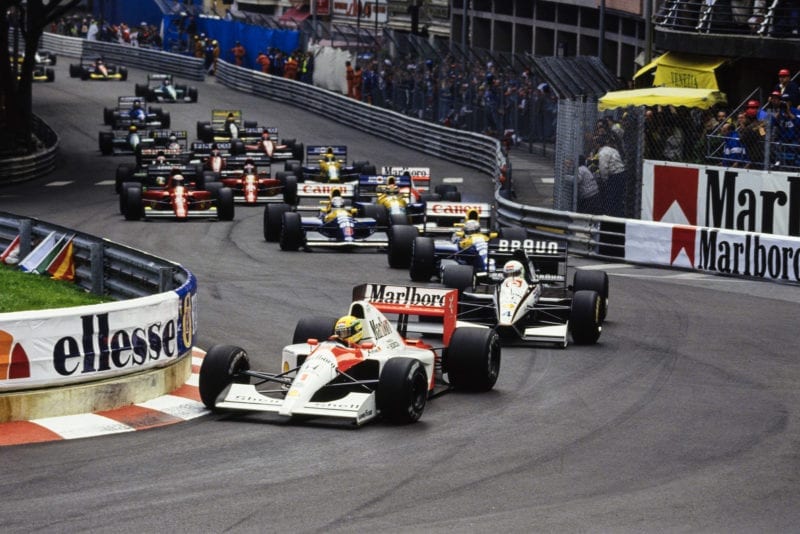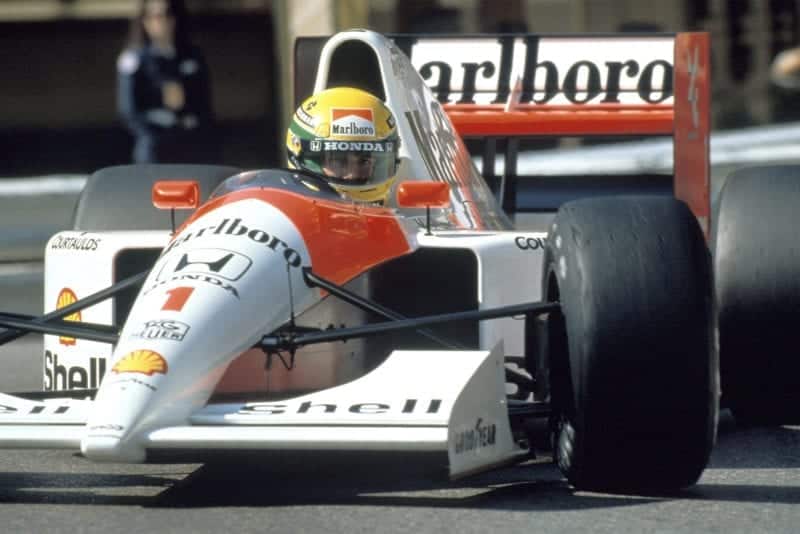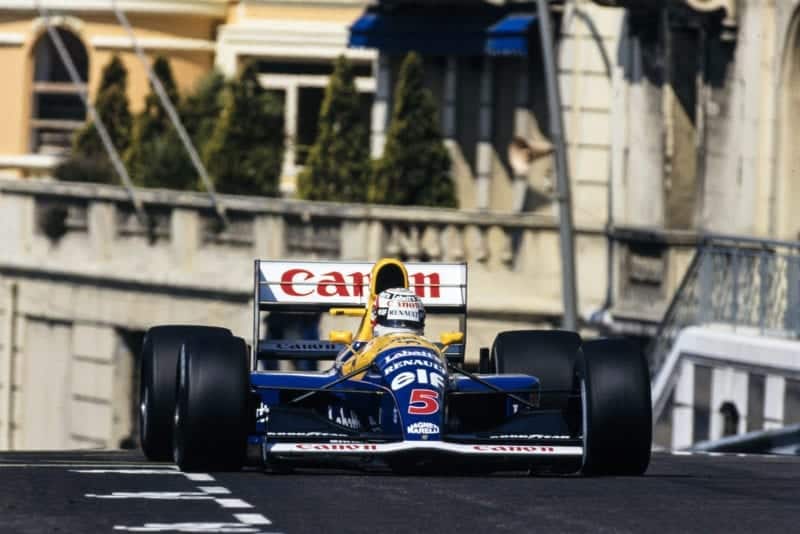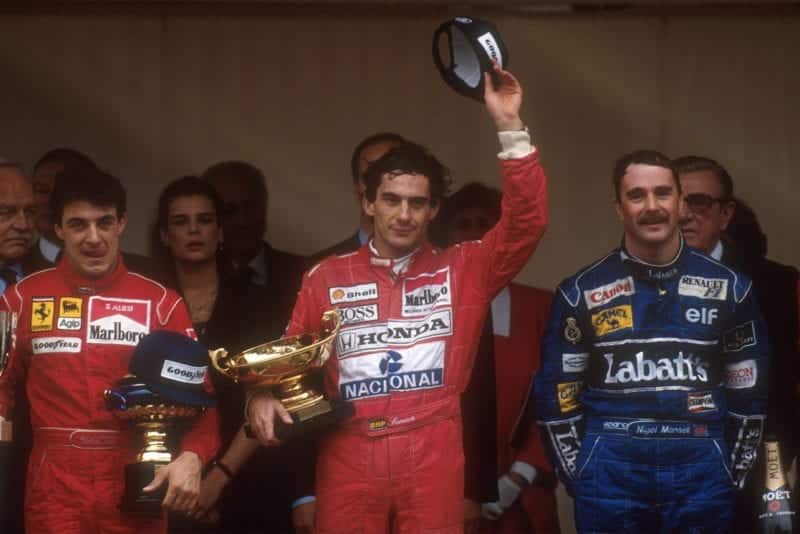Formula One: 1991 Monaco Grand Prix
Senna All The Way
Monte Carlo, May 12: Another pole position, in the lead for the entire 78 laps of the twisty circuit round the Principality, a lead of over 40 seconds on the second place man at 50 laps, sufficient to allow a considerable easing off in the closing laps to win by a comfortable 18 seconds, says it all. Yes, it was Ayrton Senna and the McLaren MP4/6 with Honda V12 power that dominated the Monaco Grand Prix, to win their fourth Grand Prix in a row, which means they have won the first quarter of the 1991 season of Formula One races with a brand new car and brand new engine, while others are still experiencing “teething troubles” with new cars, and some are experiencing troubles with old cars!
When someone appears and beats the McLaren/Honda/Senna combination fairly and squarely, not by luck or misfortune, it is going to be well worthwhile being there, for what ever the combination is it will be something very special. At the moment the rest of the Grand Prix world are getting pretty breathless trying to keep up the pace and occasionally present a small challenge, and it is not for want of trying. Williams, Ferrari, Benetton and Tyrrell were all trying their hardest throughout the Monogasque weekend, and though they collectively dealt with the McLaren number two they did not get a sniff at Senna’s tail.
There is never any pre-race testing at Monaco, so when practice starts on Thursday morning (Friday being a rest day for Formula One) it is the same for everyone and you have to know what you intend to do and get on with it pretty quickly. For once the unfortunate eight drivers who have to go straight out at 8am, without any practice at all, and vie for the four places in the event proper, had a bonus. The four fastest, which were Lehto (Dallara), de Cesaris (Jordan), Pirro (Dallara) and Gachot (Jordan) were able to start official practice with advance knowledge of the circuit conditions, and they all made good use of it. Lehto was particularly impressive with the Judd V10-powered Dallara of the Scuderia Italia from Brescia.

Senna leads the field into Sainte-Dévote
Motorsport Images
There were quite a few drivers bouncing off the guard-rails during practice and qualifying on Thursday and Saturday, even Senna joining them on Saturday morning when he hit a rail with his left rear wheel, sufficient to knock it out of line. On the other hand Alex Caffi hit the rails by the swimming pool so hard that there wasn’t much of the Porsche Footwork A12 left, and though not badly hurt it put paid to the little Italian’s activities for the weekend. Another driver who put himself out of the activity was Martin Brundle, though not in a spectacular fashion, but by infringement of a very strict rule that has no appeal. During the qualifying hour on each day there is a very efficient team of scrutineers at the entrance to the pit lane and they preside over a weighbridge. A computer chip with a random programme operates a red light, so that no-one, least of all a driver, knows when the red light is going to be on. When it shines, any car approaching must immediately deviate onto the weighbridge for a random check on the total weight of the car just as it has come in off the track. If your car weighs under the minimum, or your rear aerofoil is too high you are instantly removed from the day’s timekeeping. If you ignore the red light, for any reason what-so-ever, you are automatically excluded from the entire meeting.
Sadly, Martin Brundle missed seeing the red light on Thursday afternoon and that was the end of his Monaco GP with the Brabham-Yamaha. This weight-check during qualifying was brought about by the teams themselves some years ago, when it was discovered that some of them were running special qualifying cars that were under the legal minimum weight, yet when weighed after qualifying were found to be legal. The only thing to do was to weigh them as they qualified and the random red light system makes it the same for everyone.
Senna’s qualifying lead on Thursday was a remarkable seven-tenths of a second ahead of the next man, who was his teammate Berger, and in Formula One language a tenth of a second is an eternity! On Saturday he improved very slightly on both his runs, to retain pole position which is of vital importance on the restricted Monte Carlo circuit, but the big surprise was Stefano Modena getting into second place with the Tyrrell 020-Honda V10. Honda may no longer be using the V10 themselves, and we may have seen it last year, but it would seem to be very much a “this year’s engine” as used in the Tyrrell. The first nine places on the grid were filled by a good bunch of Grand Prix drivers, with Senna heading them all. Behind Modena was Patrese, Piquet, Mansell, Berger, Prost, Moreno and Alesi, the two Ferrari drivers still suffering from the general chaos that the Scuderia has brought upon itself, as it has done so many times in the past.

A focused Senna on his way to another Monaco victory
Motorsport Images
In tenth place was the remarkable sight of Andrea de Cesaris in the green Jordan 191 with the production spec Cosworth V8 HB engine, the car performing in a very agile and predictable manner round the twists and turns. With Caffi and Brundle eliminating themselves, there were only two disappointed drivers at the end of it all, Julian Bailey failing to qualify his Lotus 102B-Judd V8 and Fabrizio Barbazza, who has replaced Stefan Johansson in the AGS team, failing likewise.
Before the start, which was due at 3.30pm on Sunday, there was some speculation about Modena being in second place on the grid, the feeling being that he might think he can beat Senna and jump into the lead by the first corner. The speculation was over how far he would get on his first lap! In the morning warm-up period, the engine in Senna’s car did not seem completely happy so before the race was due to start, the engine was changed, and he took over the T-car, the original race car being prepared as the spare. Such is the accuracy and tool-room quality of racing cars these days, that it was a simple matter for the McLaren team to prepare what had been the spare car with an exact set-up that they had worked out with Senna for the race car. Just one of the impressive details of the all-conquering trio of Senna/McLaren/Honda. This sort of minor hiccough within the McLaren empire spreads hope among the opposition, but from the moment the green light came on, all hope faded. Senna just ran away from everyone and some of the rest fell over themselves trying to keep up.
On the first corner Berger ran into the back of Piquet’s Benetton and broke the rear suspension, as well as damaging the McLaren’s front. Piquet tried to limp round to the pits, but did not make it, though Berger did and the McLaren was repaired, allowing him to rejoin the race but very much last. He began driving really hard, lapping faster than Senna, but then came up behind another car that was losing oil which got on his visor; while trying to clean it off Berger lost concentration and at Monaco that means only one thing! He crashed into the unforgiving barriers and bent the McLaren pretty comprehensively.

Nigel Mansell crests the top of the hill in his Williams
Motorsport Images
While Senna pulled away relentlessly Modena hung on well, staying comfortably ahead of Patrese in the first Williams-Renault, and then came Mansell leading the two Ferraris. In seventh place was the almost unbelievable sight of de Cesaris going great guns in the green Jordan 191, having caught and passed Moreno in the works Benetton-Cosworth, but even more embarrassing was the fact that de Cesaris had got his sights on Alesi in the second Ferrari. Enzo Ferrari must have turned in his grave at the sight of his new young star being hounded by de Cesaris in a. . . . Jordan? Unfortunately an electrical gizmo failed and the Cosworth HB cut out completely on lap 22, which saved a lot of red faces in Maranello. With the disappearance of the Jordan the young Finnish driver JJ Lehto took over the role of the “best of the rest” doing a first class job with the Judd V10-powered car, while his team-mate Pirro in the sister car was not far behind.
Once the leaders began to lap the slower cars, Senna displayed his uncanny judgement and Modena could not hope to keep him in sight, and this allowed Patrese to close up on the Tyrrell, but he never looked like being a challenge. Prost had cautiously manouevred his way by Mansell and was splitting the Renault-powered Williams cars, but all the time Honda were running first and second, with their V12 engine and their V10 engine.
Suddenly the whole scene behind Senna changed dramatically, for as Modena came out of the tunnel onto the harbour road, there was a huge explosion behind him and the air was filled with oil and metal fragments, most of them of Japanese origin. Unfortunately Patrese was close behind and there was little he could do as he spun on the oil and smashed both ends of the Williams before coming to rest unscathed. Quietly minding his own business, and running a lap behind in 15th place, was Mark Blundell in the lone Brabham-Yamaha and he was on the oil, and into the barriers, before any warning could be given.

Senna celebrates his fourth Monaco Grand Prix victory
Motorsport Images
This bit of excitement let Prost up into second place, followed by Mansell in third place and Alesi in fourth place, but whatever the result, it had not been a Ferrari day, and it had been noticeable that Italian support among the spectators was very thin on the ground, most of them staying at home to watch television after the debacle of Imola.
As the race moved into its last 15 laps, the Honda engineers, who were monitoring Senna’s engine throughout the race by means of on-board telemetry, saw disturbing signs of oil pressure drop. They passed a message to him by radio to suggest that he did not take the engine to maximum rpm through the gears, with which he complied to give the engine a slightly easier time. He had such an enormous lead that he was able to slow down by as much as four seconds a lap, and cruise his way to his fourth victory this season.
Behind him the dramas had not finished, for Prost could feel something odd in his steering as though a front tyre was losing air. He was quite correct, for the left front wheel steering nut had slackened, allowing the wheel to wobble a small amount, but enough for the upright to machine into the wheel rirn and start an air leak. While this was happening Mansell took his chance to force his way by the Ferrari and take second place, but nearly half a lap down on Senna. When it became obvious to Prost that he would not make the finish if he went on, he arrived at the Ferrari pits unannounced. There was pandemonium while all four wheels were changed and the damage to the upright was inspected and he took off, but stalled the engine just out of reach of the manual starter lead, which wasted more time. When he got back into the race, he was down in fifth place and a whole lap and more behind the winner. It was interesting that Prost set the fastest lap of the race on his last lap, showing that there was nothing wrong with him or the Ferrari, but it did not endanger Moreno s fourth place, or Alesi’s rather dejected third. — DSJ
***
Results (top five): Monaco GP, Monte Carlo, May 12
78 laps of 3.328 km circuit (259.584 km; 161.298 miles)
1. Ayrton Senna, BRA, (McLaren MP4/6 – Honda V12) 1h 53m 02.334s
2. Nigel Mansell, GB, (Williams FW14 – Renault V10) 1h 53m 20.682s
3. Jean Alesi, F, (Ferrari F1/91 – Ferrari V12) 1h 53m 49.789s
4. Roberto Moreno, BRA, (Benetton B191 – Judd V10) 1 lap behind
5. Alain Prost, F, (Ferrari F1/91 – Ferrari V12) 1 lap behind
Conditions: Sunny and Hazy.
Winner’s average speed 137.785 kph (81.615 mph)
Fastest Lap: A. Prost (Ferrari F1/91- Ferrari V12) 1m 24.368s on lap 77; 142.006 kph (88.238 mph)
